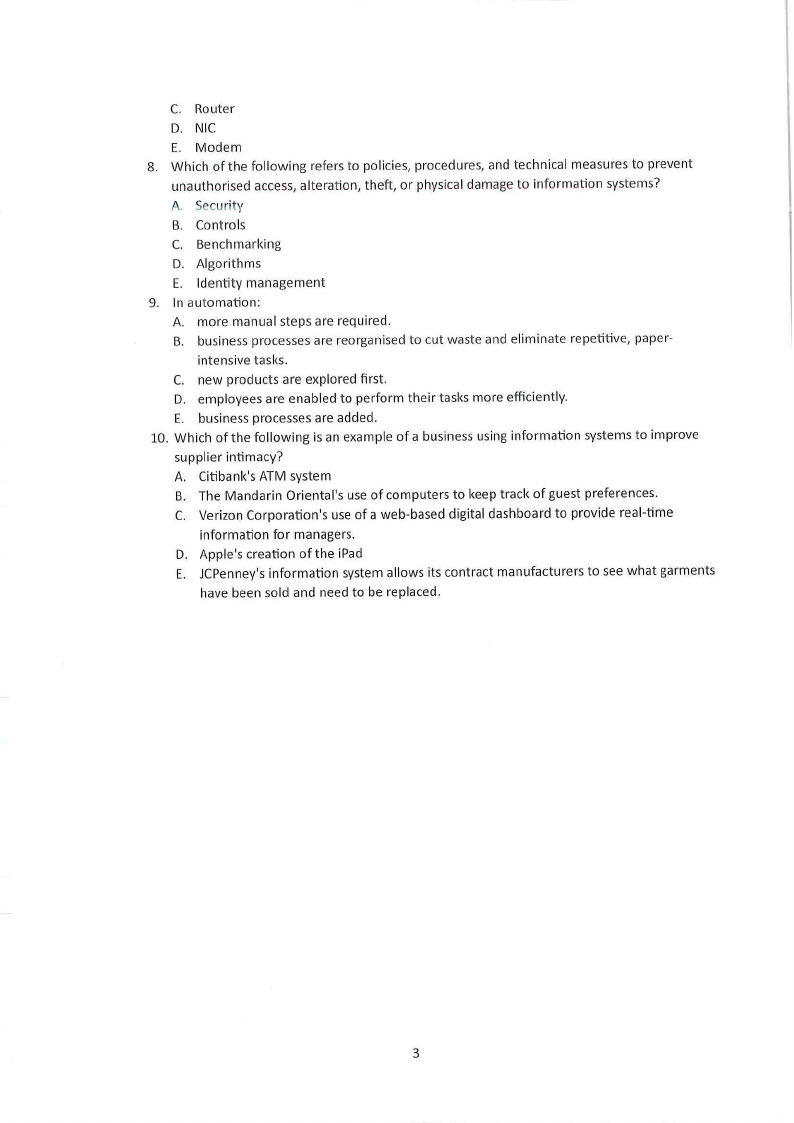 |
BMC511S - BUSINESS MANAGEMENT INFORMATION SYSTEMS - 2ND OPP - JAN 2024 |
 |
1 Page 1 |
▲back to top |

n Am I BI A u n IVER s I TY
OF SCIEnCE Ano TECHnOLOGY
FACUL Y OF COMPUTING AND INFORMATICS
DEPARTMENTOF INFORMATICS
QUALIFICATIONS:BACHELOROF LOGISTICSAND SUPPLYCHAIN MANAGEMENT
QUALIFICATIONCODE:07BLSC LEVEL:5
COURSECODE:BMCSllS
DATE: JANUARY 2024
COURSE: BUSINESS MANAGEMENT INFORMATION
SYSTEMS
SESSION:1
DURATION: 3 HOURS
MARKS: 100
SUPPLEMENTARY/SECONDOPPORTUNITYEXAMINATION QUESTION PAPER
EXAMINERS:
Dr Munyaradzi Maravanyika
MODERATOR($):
Mr Nkululeko Mthembo
THIS EXAMINATION PAPERCONSISTSOF 5 PAGES
(INCLUDING THIS FRONTPAGE)
INSTRUCTIONSFORTHE CANDIDATE
1. Answer all questions.
2. When writing, consider the following: The style should be to inform rather than
impress.
3. Information should be brief and accurate.
4. Please ensure that your writing is legible, neat and presentable.
 |
2 Page 2 |
▲back to top |

SECTIONA: MULTIPLECHOICE
(20 MARKS]
1. Which of the following is not one of the six strategic business objectives businesses seek to
achieve when investing in information systems?
A. Operational excellence
B. Improved decision making
C. Improved community relations
D. Competitive advantage
E. Survival
2. A firm that invests in an information system because it is necessary to do business does so
because it seeks to achieve which of the following business objectives?
A. Operational excellence
B. Improved decision making
C. Competitive advantage
D. Customer intimacy
E. Survival
3. Which type of infrastructure service stores and manages corporate data and provides data
analysis capabilities?
A. Networking
B. Telephone
C. VOiP
D. Telecommunications
E. Data management
4. Which of the following is a multitasking, multiuser operating system developed by Bell
Laboratories that operates on various computers from different manufacturers?
A. Unix
B. Wintel
C. OSX
D. COBOL
E. DOS
5. All of the following are issues with the traditional file environment except:
A. data inconsistency.
B. inability to develop specialised applications for functional areas.
C. lack of flexibility in creating ad-hoc reports.
D. poor security.
E. data sharing.
6. A(n) ____
is used to communicate between a user and an organisation's back-end
systems.
A. public server
B. private server
C. legacy server
D. application server
E. blade server
7. Which of the following is a device that sends packets of data through different networks,
ensuring they go to the correct address?
A. Hub
B. Switch
2
 |
3 Page 3 |
▲back to top |

C. Router
D. NIC
E. Modem
8. Which of the following refers to policies, procedures, and technical measures to prevent
unauthorised access, alteration, theft, or physical damage to information systems?
A. Security
B. Controls
C. Benchmarking
D. Algorithms
E. Identity management
9. In automation:
A. more manual steps are required.
B. business processes are reorganised to cut waste and eliminate repetitive, paper-
intensive tasks.
C. new products are explored first.
D. employees are enabled to perform their tasks more efficiently.
E. business processes are added.
10. Which of the following is an example of a business using information systems to improve
supplier intimacy?
A. Citibank's ATM system
B. The Mandarin Orienta l's use of computers to keep track of guest preferences.
C. Verizon Corporation's use of a web-based digital dashboard to provide real-time
information for managers.
D. Apple's creation of the iPad
E. JCPenney's information system allows its contract manufacturers to see what garments
have been sold and need to be replaced.
3
 |
4 Page 4 |
▲back to top |

SECTIONB: STRUCTUREDQUESTIONS
(80 MARKS]
1. How can information systems and information technology be used to improve business
processes? (10 marks]
2. Identify and discuss the major types of information systems used by different levels of
management within a business. What are the relationships among these systems? (10 marks]
3. List and briefly describe three main capabilities or tools of a DBMS. (10 marks]
4. Explain what the term big data refers to. What benefits does it have, and what challenges does
it pose? (10 marks]
5. List at least nine factors considered in the design specifications for a new system. Give at least
two examples for each one. (20 marks]
6. Discuss the role end users play in the systems-building effort. (10 marks]
7. Briefly describe the four main conversion strategies for changing from an old to a new system.
(10 marks]
END OF PAPER
4





